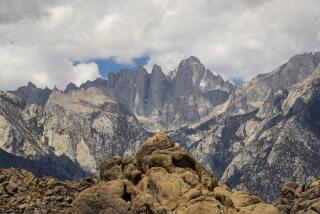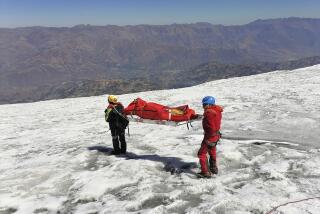Mt. Everest Climb Yields Peak Health Data
- Share via
NEW HAVEN, Conn. — In the end, Mt. Everest humbled--but did not defeat--modern technology.
An expedition whose climbers wore tiny sensors tracking their health found that not all of their high-tech equipment worked properly under the extreme conditions--frigid temperatures, tremendous air pressure and an acute lack of oxygen at higher altitudes.
Nevertheless, doctors and scientists at Yale University, the Massachusetts Institute of Technology and the Boston Museum of Science said recently that they already have learned much about how high-tech equipment and the body function in the harshest of climates.
“Most everything worked,” said Brad Geilfuss, a researcher who monitored the expedition from a laboratory at MIT. “It didn’t necessarily work the way we planned, but it worked.”
Four climbers attempted to carry 2-pound “bio-packs” with sensors measuring the amount of oxygen in their blood, their heart rates, skin temperature and body temperature during the climb.
Some climbers also tried to carry 1 1/2-pound “geo-packs” to pinpoint their location and measure temperature, air pressure, humidity and light. One researcher said the geo-packs could also aid rescuers in case of a disaster.
Some of the information was transmitted to Yale, MIT and the Walter Reed Army Medical Center in Washington during the expedition.
Climbers also participated in regular “telemedicine” video conferences from the mountain with researchers monitoring their health thousands of miles away in the United States.
Of the whole team, only expedition leader Wally Berg of Colorado and a native Nepalese guide, Appa Sherpa, reached the summit of the world’s highest mountain, reaching the peak of 29,028 feet above sea level on May 20.
Neither man was wearing the packs when they reached the summit because the added weight was too much of a burden. Berg carried his packs the farthest, until he reached a camp at 23,500 feet.
“We didn’t want to interfere with his summit bid,” said MIT researcher Matthew Lau, who was at a base camp at 17,500 feet.
“We wanted him to have every chance of making it.”
But the packs are still useful, the scientists said, because they recorded and stored the data.
Berg did accomplish one of the major goals of the trip. While atop Everest, he set up a 12-pound Global Positioning System receiver to measure the geological speed at which India is sliding under Tibet. Because of geological shifts, the mountain is actually getting higher, rising about an inch every year.
And, while drilling a hole into solid rock to set up the receiver, Berg spent about two hours on the summit--believed to be a record.
Bradford Washburn of the Museum of Science said that by installing the GPS system, Berg has laid “the foundation for geophysical work on Everest for years to come.”
The system remained atop Everest until climbers from Singapore retrieved it four days later.
In future years, other teams will carry a GPS system to the summit and take readings to see how the mountain’s latitude, longitude and altitude are changing.
“This is another leap forward. There is still more to come,” Washburn said.
A medical team on Everest examined more than 75 climbers from various international expeditions. Some suffered from maladies ranging from upper respiratory infections to stomach problems.
A lack of oxygen at high altitudes can impair decision-making and can cause headaches, sluggishness and a lack of coordination.
The extremely cold temperatures and dry air can cause frostbite and what is known as the Khumbu cough.
Dr. Peter Angood, director of the Yale School of Medicine surgical critical care program and one of the researchers tracking the climbers from New Haven, said he and the other doctors hope to identify trends in their health.
“We feel the project was successful. All climbers remained healthy. The physiologic research, the video conferences, went well,” Angood said.
Researchers in the MIT media lab will try to solve several equipment failures, including batteries that failed in cold temperatures and switches and computer hard drives that fell short because of air pressure.
“We learned that the mountain is at least as harsh as everyone makes it out to be and a very difficult environment to work in,” Lau said. “Man has by no means conquered Mt. Everest.”
More to Read
Sign up for Essential California
The most important California stories and recommendations in your inbox every morning.
You may occasionally receive promotional content from the Los Angeles Times.










